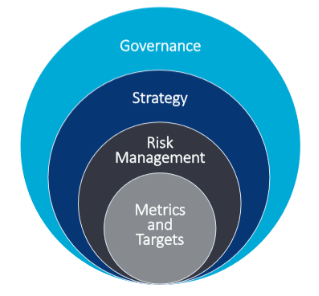
September 20, 2022
Rae Oliver
The climate crisis poses a range of risks to financial institutions, investors, businesses and individuals. Both transitional and physical risks could materially impact organizations and their assets. The effects of higher temperatures, more extreme weather events, and resulting changes in markets, regulations, and technology can all cause issues.
Disclosures of climate-related information can help to structure investment decisions and drive the world’s transition toward a lower carbon economy. It’s becoming increasingly easy to compare firms’ climate risks and opportunities. In turn, this better informs investors on methods to incorporate these risks into their decisions. Furthermore, transparent disclosures provide more data to other internal and external stakeholders to make more informed and intelligent decisions.
The recommendations of the Task Force on Climate-Related Financial Disclosures (TCFD) form one of the most effective frameworks available. With the TCFD businesses can analyze and disclose climate-related risks and financial information. The TCFD’s widespread acceptance across firms, governments and investors has led the UK government to adopt its guidelines as the basis for implementing the UK climate disclosure requirements across the nation’s economy.
The TCFD is the Task Force on Climate-Related Financial Disclosures. It constitutes a framework developed by the financial and investment authorities of the world’s most important economies. It’s structured around four thematic areas of operation:

The TCFD was established by the Financial Stability Board (FSB) in 2015. The TCFD is an organization dedicated to promoting worldwide financial stability. The Task Force focuses on reporting the impacts of organizations on the global climate. It seeks to ensure that these firms’ climate disclosures are more accurate, transparent, and comparable. The purpose of these efforts is to enable companies to incorporate climate-related opportunities and risks into their strategic plans, risk management plans, and decision-making processes.
The Task Force has developed a reporting framework based on a range of disclosure guidelines. The guidelines are designed to be used by companies to provide data about their climate-related risk exposures to lenders, investors, underwriters, and other relevant stakeholders. The framework improves the quality and consistency of climate-related financial information, allowing economies to better assess the impacts of organizations on climate change. The TCFD is supported by over 1,700 organizations globally. This includes governments like the UK’s, which has used the framework to formulate its UK mandatory climate disclosure regulations.
Britain was the world’s first major economy to make TCFD climate-related disclosures mandatory for all local businesses. Organizations listed on the London Stock Exchange’s premium market have been required to make climate-related disclosures to their investors in line with the TCFD’s guidelines since 2021.
Firms are required to disclose a wide range of climate-related information in line with the four key pillars of the TCFD – governance, strategy, risk management, and targets and metrics. The UK government has also introduced a qualitative scenario analysis requirement. This requires in-depth analyses of the resilience of business strategies in models, taking into consideration an array of different climate-related scenarios.
Companies and their assets face both physical and transition risks in the face of the warming global climate. Physical risks are those which arise from the impacts of higher average weather temperatures and the increased regularity of catastrophic weather events. Transition risks arise from changes in tools, technologies, markets, and consumer expectations which will arise during the net zero transition.
The UK mandatory climate disclosure requirements require companies and LLPs to incorporate TCDF-aligned climate disclosures in their annual reports. The disclosures must cover:
Companies must include this information in their Non-Financial and Sustainability Information Statements in their Strategic Reports. LLPs must include disclosures in their Energy and Carbon Report of their Directors’ Reports or, for LLPs which prepare a Strategic Report, in this report.
The UK government has estimated that around 1,300 organizations will need to incorporate climate disclosures in their annual report. The disclosure requirements apply to all companies that are currently required to produce an annual non-financial information statement. This includes listed companies, banks or insurers with more than 500 employees. Not complying with the new disclosure requirements could result in fines of a minimum of £2,500 and a maximum of £50,000.
SINAI can help you take a more structured approach to ESG measurement and reporting. Our first in class decarbonization platform offers scenario analysis tools to determine the impacts of the financial risks from climate change on your overall risk profile and business strategy.
Request a demo of our platform to discover how SINAI can help your organization meet the new UK climate disclosure requirements consistently and accurately.


